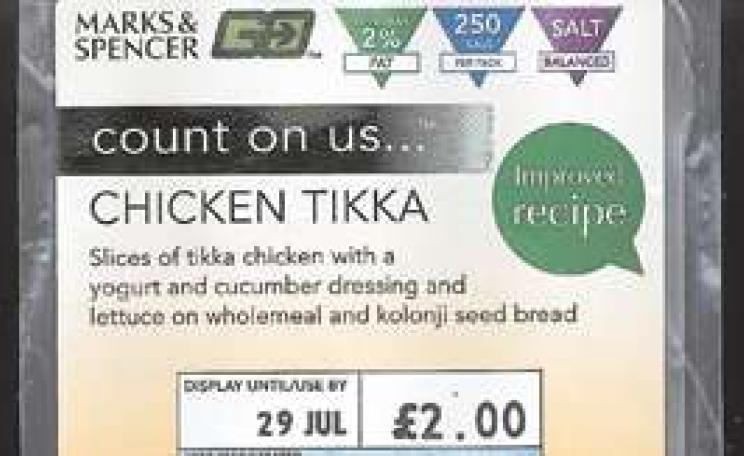It’s embarrassing, isn’t it, to come from a country with a bad food culture? But that’s how other countries see us: as a nation hooked on junk food. It’s part of our national stereotype. Au pairs return home to regale their astounded families with tales of what British households eat. Visitors remark on the absence of food shops; their jaws drop at the sight of legions of office workers bolting down their lunchtime sandwiches or schoolchildren breakfasting on packets of crisps and cans of coke.
Theories about the roots of Britain’s gastronomic cluelessness stretch back to the enclosures and the Industrial Revolution – the dislocation of food-producing peasants from the countryside to make an industrial workforce, and so on. But increasingly, historical explanations seem inadequate to explain fully our current predicament. One contemporary factor is staring us in the face. No country in Europe is so reliant on supermarkets for its food shopping.
These days, many British consumers simply see no alternative to shopping in supermarkets; that is not the case in countries where people eat better.
A Britain in which supermarket hegemony is challenged is invariably portrayed by our large retailers as a grim, inconvenient, post-rationing nightmare world, where no one has ever heard of kiwi fruit and we are all condemned to a monotonous diet of dull, labour-intensive raw ingredients. ‘Queuing at one store, then trudging down Watford High Street in the rain to another shop... Is this what people actually want to go back to?’ asked Tesco’s chief executive Sir Terry Leahy.
Using that approach, supermarkets habitually present themselves as a progressive solution to Britain’s food difficulties, when in fact their enormous power to determine what ends up on our plates is a major part of the problem of our food culture. It is no coincidence that the country most attached to supermarket shopping has the worst eating habits in Europe, because we have effectively surrendered control over what we eat to a few powerful chains. In the guise of giving us choice, they simply sell us what suits them.
The particularly audacious thing about the supermarket prepared-food revolution is the way that supermarkets have taken the culinary limitations of industrial food processing and put a positive spin on them. They claim – erroneously – that their innovation has broadened the British palate and introduced new tastes and flavours. In fact, they are mainly selling us the same standard components, continuously re-assembled and re-marketed in a multiplicity of forms. But since their clientele shop routinely in their stores, and so lack any alternative point of reference, this fact usually goes unchallenged. Supermarkets know that, because they increasingly control where we shop, the public can be conditioned, by repetition and force of habit, to believe that supermarket TV dinners of the 21st century are better than anything they might cook, and possibly even just as good as what they might encounter abroad.
To sustain this tall tale, supermarkets appear to have set themselves a mission of subverting home cooking – the bedrock of any true food culture. Every supermarket chain churns out a stream of recipe cards that purport to encourage home cooking. But home cooking does not make enough money for supermarkets, which want the extra margins that can be slipped in with processing. The profits that can be made from convincing people that they don’t need to mash a potato or wash a salad are substantial. So increasingly, supermarket shelves are filled with foods that obviate, or at least minimise, the need for any home cooking, and make the stores’ owners a tidy profit at the same time. When chef Rowley Leigh was asked to sample Marks & Spencer ready meals, he estimated that a St Michael pasta and vegetable bake priced £1.99 would cost only 40 pence to make at home, while a beef casserole priced £5.58 would cost £1.50 if home-made. Food writer Matthew Fort said: ‘Hand in hand with the microwave and the deep freeze – and ably supported by manufacturers and retailers who can gouge higher profit margins on these ‘‘value-added’’ products – convenience foods have all but eliminated the tradition of domestic cookery from British homes.’ Supermarkets have played the major role in this, providing the means by which the UK has become a ‘can’t cook, won’t cook’ nation, where the idea of a gourmet night is eating a supermarket ready meal on a tray while watching a procession of celebrity chefs cook fantasy food on TV.
The Great British Cookery Paradox is evidence that supermarkets have made substantial inroads in undermining the nation’s inclination to cook. In spite of the plethora of TV cooking programmes, cookery books and cookery articles in magazines and newspapers, less and less cooking is being done in homes up and down the land. In 2002, British TV screened 4,000 hours of food programmes, and 900 food books and 25 million words about food and cookery were published in this country. But we seem to spend more time watching chefs cook than cooking ourselves. In 1980 the average meal took one hour to prepare; now it takes 20 minutes; it is predicted that this figure will shrink to eight minutes by 2010. The UK has become a nation of food voyeurs rather than cooks, and supermarkets have supplied both the means and the motive. Market analyst Keynote concluded: ‘People who are proficient in cooking... are now beginning to represent a declining proportion within the population... They are arguably also more likely to recognise the difference in cost between purchasing ingredients for home cooking and buying prepared meals.’ In other words, the more you cook and know about food, the less you are likely to see supermarket prepared food as either desirable or good value.
For years supermarkets have fostered the idea that all over the UK people are passing off ready meals as home-cooked food without anyone being any the wiser. If that is indeed true, it is a sad indictment of our food awareness. But the proposition strains credulity somewhat. Though it might be possible to pass off a supermarket ready meal as home-made to those whose only point of reference is pot noodles, most people can easily spot the difference, if only because supermarket ready meals look and taste depressingly familiar. Most recently, supermarkets have developed ranges of ‘better-than-the-rest’ labels, more upmarket-looking and -sounding ‘gourmet’ brands such as Safeway The Best, Tesco’s Finest and Asda’s Extra Special. These ranges are an attempt by supermarkets to head off criticism that their food all tastes over-processed and industrial, and to keep people interested by inserting an aspirational top range into their portfolios.
Having successfully planted the idea that there is no need to cook because factory food is at least as good as, if not better than, the home-made equivalent, supermarkets have sought to extend their gastronomic empire by fostering the idea that there is no need to eat out in restaurants either. In this regard, the most daring stunt has been performed by Sainsbury’s with its Bombay Brasserie meal kits, named after the celebrated London restaurant. The range is manufactured by Noon Products, whose chairman, Sir Gulam Noon, has described it as a way for Sainsbury’s shoppers who live outside London to ‘create their own Bombay Brasserie at home’. Noon said his company had worked very closely with the brasserie’s chefs ‘to ensure all the dishes were produced to restaurant standards’, encouraging us to believe the implausible proposition that when we reheat a factory curry meal at home it will look and taste the same as one freshly prepared on the spot by top Indian chefs in one of the UK’s foremost restaurants.
If you habitually shop in one supermarket chain for ready meals, you might occasionally wonder if you are missing out on variety by not trying out rival chains’ offerings. Don’t. There’s a very, very strong chance that despite their being sold by different chains, the contents of those boxes will resemble one another closely.
Carry out a ‘tried and tasted’ comparison – a popular tactic in consumer journalism for comparing the relative contents of various supermarket chains’ offerings – and the resemblance between the appealingly packaged ready meals that line our supermarket shelves is striking. In 2003 Asian food expert Ken Hom performed precisely such a test on supermarket Thai green curry, sampling those sold by Tesco, Sainsbury’s, Waitrose, Somerfield and Marks & Spencer. The parameters of magazines’ tried-and-tested comparisons are often skewed towards supermarkets – a reflection of the chains grip on the nation’s psyche. Usually, for example, only supermarket samples are tested, and no restaurant or home-made samples are included in the comparison. An internal hierarchy is established, even if the entire category is lacking in merit. But the results in this particular taste test were more candid than usual. They spoke volumes about the homogeneity of supermarket food. The same taste criticisms came up again and again: ‘dry chicken’; ‘not spicy’; ‘overly sweet’; ‘not at all authentic’. Though the inevitable ratings implied that one chain’s offering had some slight merit over the others, Hom sounded distinctly underwhelmed. One tasted ‘more like an airline meal’; another was ‘not green curry as I know it’. The highest score went to ‘the best of the bunch’. One sensed that given a free hand, Hom might have been happier offering a Eurovision Song Contest ‘nul points’ to the whole lot.
The fact that one chain’s Thai green curry tastes pretty much like all the others – and not at all like any green curry you’d ever encounter in Thailand – is scarcely surprising. There’s a good chance that they’re made by the same company. Between 1995 and 2000, for example, Hazlewood Foods was a major chilled-meals supplier to Sainsbury’s, Tesco, Waitrose and Morrisons; S&A to Tesco, Safeway and Asda; Northern Foods to Marks & Spencer, Sainsbury’s and Tesco; Geest to Sainsbury’s and Tesco; and Noon to Sainsbury’s and Waitrose. Another company, Uniq, has helped develop low-fat, ‘healthy-eating’ product ranges such as Marks & Spencer’s Count On Us, Sainsbury’s Be Good To Yourself, Safeway’s Eat Smart and Asda’s Good For You.
Of course, one cannot automatically assume, because of this clubby overlap, that supermarkets can’t instruct their suppliers to introduce a genuine ‘point of difference’ to distinguish their offerings from each other. Recipes may differ, ingredients may come from distinct sources, and so on. But taste your way around a few supermarket chilled meals and you will begin to notice how the white sauce in one chain’s cod and parsley pie is surprisingly like another chain’s moussaka topping, how the tomato goo on top of your pizza tastes oddly reminiscent of the tomato and basil sauce for your Mediterranean-style pasta, how the Mexican salsa tastes like the Spanish gazpacho, and how if you sampled the sauce on those Malaysian sweet chilli prawns blind you might easily confuse it with the gravy on the lamb steak with redcurrants.
Think about it a little longer and you’ll pick up the same defining characteristics in almost all savoury supermarket-prepared meals. Any meat will probably be overcooked and dry – a consequence of bulk factory cooking followed by domestic reheating. A salty savouriness without any particular flavour profile prevails. Where a sauce or a liquid element is present, a gloopy consistency is de rigueur. Last but not least, don’t be surprised if the meal bears little resemblance to the picture on the box. That enticing image, after all, is the product of long hours of toil put in by a team of food stylists, lighting managers and photographers.
Clearly, when so much food is made for our supermarkets by the same companies the results are likely to resemble one another. The same state-of-the-art factory-line technologies and automated short cuts are used. Any personality is beaten out of the ingredients by the time they have been subjected to the various interventions of large-scale food processing. Hence the institutionalised sameness of supermarket ready meals.
Lest consumers begin to tire of this uniformity, supermarkets go in for what is known as ‘sub-branding’ or ‘segmentation’. When their shoppers begin to feel like children at Christmas, rather jaded with their new toys, supermarkets like to feed us a stream of novelties that appear to refresh the category even though they are essentially variations of the same thing. It’s just like Barbie, the doll with the abundant hair, pert breasts, long legs and impossibly narrow hips. There is Beach Barbie, Air Hostess Barbie, Aerobic Barbie and so on, but she always has the same essential hair, breasts, legs and hips. Supermarket ready meals are the food equivalent: they might as well be Thai Barbie, Bistro Barbie, Café Society Barbie, Vegetarian Barbie or Indian Takeaway Barbie. They look superficially different, but the underlying prototype remains the same. The resemblance stops there, though, because unlike Barbie most supermarket ready meals don’t look good when they come out of their packaging. They look like what they are: a disappointingly slight, unappetising pile of overcooked food in a plastic tray.
Any positive selling point or new-sounding concept can, in supermarket speak, be ‘rolled out’ into stores to create a new range. Better-than-the-rest, ready-to-cook and ‘value’ ranges, lines that promote healthy eating or cater for special dietary needs like Sainsbury’s Wellbeing or Safeway’s Eat Smart, and celebrity-chef collections are all concepts that allow the creation of whole new family groups or tiers of products, products that are as desirable and collectable to trusting consumers as Pokemon cards and football stickers.
These ranges boost the own-brand power of the chain by increasing the number of ‘facings’ with which shelves can be filled, preventing customer ennui from setting in and shoppers from drifting elsewhere.
Just as we are beginning to notice that our supermarket’s chicken korma, for example, is expensive for what it is, not to mention pretty dull, the chain will relaunch it in a new, exciting ‘Regional Indian’ format, only tweaking the product itself but radically altering its appearance and the marketing pitch on the box. With only minor adjustments, factory spaghetti bolognese can be reinvented as spicy Manhattan meatballs with spaghetti. A change of packaging and, hey presto, chilli con carne becomes a chilli beef bowl. A few standard dishes, minimally altered then packed in a brown paper takeaway bag, can become a restaurant ‘Chinese banquet’. Unable or unwilling to give us the true variety that comes from using a large number of suppliers with geographically distinctive, often seasonal foods, supermarkets offer instead the phoney choice of the merchandised factory meal in its seemingly infinite chameleon-like forms.
Sainsbury’s summed up the UK’s supermarket chains’ claims to broaden the British palate when it said it could supply ‘everything you need to launch you on a round-the-world voyage of culinary discovery’. For an example of what it had in mind, take its ‘American-style mini battered chicken fillets with a honey and mustard sauce’. These look and taste indistinguishable from any number of other battered chicken products on supermarket shelves. It is not at all clear what is American about them. Their label says: ‘Produced in Thailand... This product has been previously frozen and defrosted under controlled conditions making it suitable for re-freezing.’ So there you have it: an unremarkable bit of battered chicken reared and manufactured in Asia (where chicken is produced at a lower cost than in the UK) to a nominally American recipe, which is then sent frozen from the other side of the world to be defrosted in the UK so you can re-freeze it at home. Is that a globetrotting foodie adventure worth having?
With such creations, far from broadening the UK’s palate, supermarkets have conditioned it to accept travesties of the real thing. Supermarket convenience foods flirt with foreignness, exoticism and authenticity, but their taste remains essentially conservative, upholding the salty-sweet, gloopy status quo of industrial food production. As Safeway’s buying manager for prepared foods put it, ‘authenticity is not necessarily what people want, so we try to marry authenticity with the British palate’. The truth is that supermarket prepared food can’t be made to taste like a good example of the real thing, and so supermarkets must feed consumers a dumbed-down version with a positive spin put on it. They have done so with notable success. British consumers, for example, spend £7,000 a minute on ready meals; that’s three times more than any other country in Europe. Spending on these meals is set to soar to £5 billion per year by 2007. Cultural commentator Jonathan Meades once said that supermarkets have thrived on what he calls ‘the British indifference to flavour, freshness and quality, the British preoccupation with the appearance of foodstuffs, the British insistence on choice’. How right he was.
Extracted from Shopped: The Shocking Power of British Supermarkets by Joanna Blythman published by Fourth Estate, 2004.
Always read the label
They look good in the box and sell for a considerable premium, but the ingredients lists of aspiring home-entertaining specials can provide illuminating evidence of the gastronomic gulf between them and the home-cooked article. The ingredients list for a classic French boeuf bourguignon, for example, is relatively short and sweet, containing no unfamiliar or synthetic ingredients. The equivalent list on one supermarket’s ‘better-than-the-rest’ equivalent ran to a substantial paragraph, and you need a degree in chemistry to decode it.
Ingredients in Elizabeth David’s recipe for boeuf bourguignon(from French Provincial Cooking):
Beef, salt pork or unsalted streaky bacon, onion, thyme, parsley, bay leaves, red wine, olive oil, meat stock, garlic, flour, mushrooms, meat dripping
Ingredients in a supermarket’s ‘better-than-the-rest’ boeuf bourguignon casserole:
Beef, water, red wine, baby onion, bacon lardons (pork belly, water, salt, dried glucose syrup, stabilisers, sodium polyphosphate, sodium triphosphate, disodium diphosphate, preservative, sodium nitrite, antioxidant, sodium ascorbate, smoke flavouring), onion, modified maize starch, beef stock (concentrated beef broth, yeast extract, glucose, salt, vegetable fat, water, emulsifier, mono- and di-glycerides of fatty acids, rosemary extract), celery, carrot, vegetable stock (with emulsifier: mono- and di-glycerides of fatty acids), vegetable oil, white wine vinegar, salt, pork gelatine, thyme, dried glucose syrup, garlic purée, acidity regulators (sodium acetate, sodium citrate), ground bay, antioxidant (sodium ascorbate).
Even allowing for the additional information for manufactured food required under labelling regulations, the contrast underlines how a supermarket ready meal in a box is a very different animal from its home-cooked equivalent. An advert for Tesco’s Finest range said: ‘It’s like a top chef preparing dinner for you at a moment’s notice.’ But how many top chefs use ingredients such as dried glucose syrup, mono- and di-glycerides of fatty acids, or acidity regulator?
This article first appeared in the Ecologist September 2004







